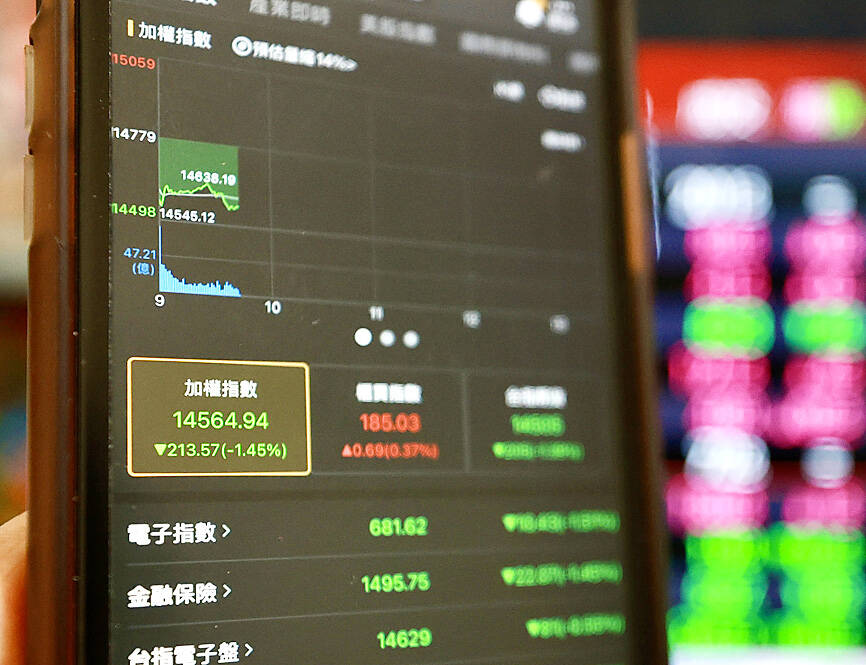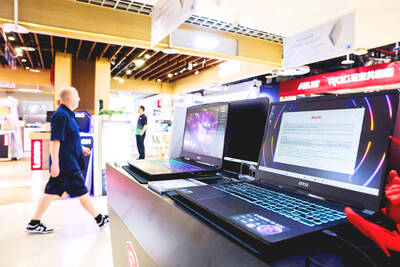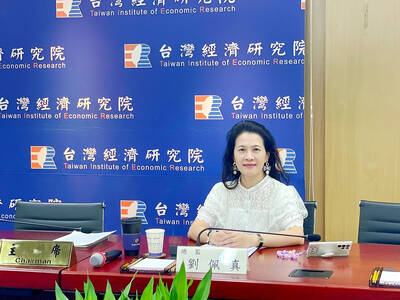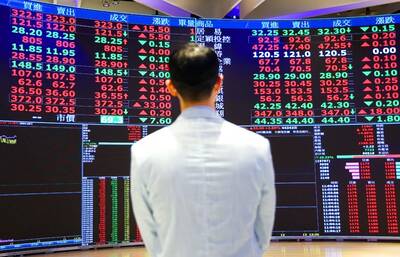Taiwanese shares came under pressure yesterday, as selling was sparked by losses suffered by tech stocks on Wall Street last week, while buying rotated to the tourism sector due to the easing of border controls.
The TAIEX ended down 221.64 points, or 1.50 percent, at 14,556.87. Turnover on the main board totaled NT$198.444 billion (US$6.4 billion), with foreign institutional investors selling a net NT$10.77 billion of shares, Taiwan Stock Exchange data showed.
“After the nine-in-one local elections on the weekend, many investors shifted their attention back to the fundamentals,” Concord Capital Management Corp (康和投顧) analyst Lu Chin-wei said. “Worries have re-emerged over inventory adjustments in the global semiconductor industry, with many investors punishing large tech stocks throughout the session today.”

Photo: CNA
Taiwan Semiconductor Manufacturing Co (台積電), the most heavily weighted stock on the local market, tumbled 3.51 percent to close at the day’s low of NT$480.5. The stock’s losses contributed more than 140 points to the TAIEX’s fall.
An escalation of protests in China against the government’s “zero COVID-19” policy also weighed on the local market as many investors feared that the unrest would hinder production and hurt demand in the world’s second-largest economy, leading to selling of export-oriented tech stocks in Taipei, Lu said.
Local election results might only impact markets for a day, Uni-President Assets Management Co (統一投顧) chairman Li Fang-kuo (黎方國) said, adding that “we are still positive on the outlook of stocks, as TAIEX usually rises in December.”
The old economy stocks mostly moved in a narrow range throughout the session, while the tourism sector attracted strong buying, jumping by 2.48 percent, on hopes that the easing of pandemic border controls would push up the number of arrivals and boost revenue.
The New Taiwan dollar lost NT$0.107 to close at NT$31.012 against the US dollar in Taipei trading yesterday.
The local currency, which has risen more than 4 percent this month, would probably weaken to about NT$33 against the greenback by the end of the first quarter, Mizuho Bank Ltd and RBC Capital Markets forecast, as overseas shipments shrink for a second straight month. The outlook isn’t bright with a global recession looming and big tech shedding jobs, while COVID-19 infections rise in China — the biggest trading partner of Taiwan's export-reliant economy.
Goldman Sachs Group Inc also said this month it’s underweight on the NT dollar as geopolitical risks could lead to foreign selling of Taiwanese shares.
Despite its recent rebound, the NT dollar is down more than 10 percent this year — set for its steepest slide since 1997 — given a widening rate differential with the US.
The central bank hiked interest rates by only 50 basis points this year, among the smallest in Asia, even as the US Federal Reserve raised interest rates by 375 basis points. Taiwanese policymakers are next to decide on rates on Dec. 15.
“We expect the Taiwan dollar to revert to 32 to 33 level in the medium term, as the recession will dampen demand for Taiwan’s electronic exports,” Mizuho Bank foreign exchange strategist Ken Cheung (張建泰) said. “The central bank’s rate hike pace will also lag the Federal Reserve’s rate hike cycle, and the currency will stay soft compared to its peers.”

IN THE AIR: While most companies said they were committed to North American operations, some added that production and costs would depend on the outcome of a US trade probe Leading local contract electronics makers Wistron Corp (緯創), Quanta Computer Inc (廣達), Inventec Corp (英業達) and Compal Electronics Inc (仁寶) are to maintain their North American expansion plans, despite Washington’s 20 percent tariff on Taiwanese goods. Wistron said it has long maintained a presence in the US, while distributing production across Taiwan, North America, Southeast Asia and Europe. The company is in talks with customers to align capacity with their site preferences, a company official told the Taipei Times by telephone on Friday. The company is still in talks with clients over who would bear the tariff costs, with the outcome pending further

A proposed 100 percent tariff on chip imports announced by US President Donald Trump could shift more of Taiwan’s semiconductor production overseas, a Taiwan Institute of Economic Research (TIER) researcher said yesterday. Trump’s tariff policy will accelerate the global semiconductor industry’s pace to establish roots in the US, leading to higher supply chain costs and ultimately raising prices of consumer electronics and creating uncertainty for future market demand, Arisa Liu (劉佩真) at the institute’s Taiwan Industry Economics Database said in a telephone interview. Trump’s move signals his intention to "restore the glory of the US semiconductor industry," Liu noted, saying that

STILL UNCLEAR: Several aspects of the policy still need to be clarified, such as whether the exemptions would expand to related products, PwC Taiwan warned The TAIEX surged yesterday, led by gains in Taiwan Semiconductor Manufacturing Co (TSMC, 台積電), after US President Donald Trump announced a sweeping 100 percent tariff on imported semiconductors — while exempting companies operating or building plants in the US, which includes TSMC. The benchmark index jumped 556.41 points, or 2.37 percent, to close at 24,003.77, breaching the 24,000-point level and hitting its highest close this year, Taiwan Stock Exchange (TWSE) data showed. TSMC rose NT$55, or 4.89 percent, to close at a record NT$1,180, as the company is already investing heavily in a multibillion-dollar plant in Arizona that led investors to assume

AI: Softbank’s stake increases in Nvidia and TSMC reflect Masayoshi Son’s effort to gain a foothold in key nodes of the AI value chain, from chip design to data infrastructure Softbank Group Corp is building up stakes in Nvidia Corp and Taiwan Semiconductor Manufacturing Co (TSMC, 台積電), the latest reflection of founder Masayoshi Son’s focus on the tools and hardware underpinning artificial intelligence (AI). The Japanese technology investor raised its stake in Nvidia to about US$3 billion by the end of March, up from US$1 billion in the prior quarter, regulatory filings showed. It bought about US$330 million worth of TSMC shares and US$170 million in Oracle Corp, they showed. Softbank’s signature Vision Fund has also monetized almost US$2 billion of public and private assets in the first half of this year,